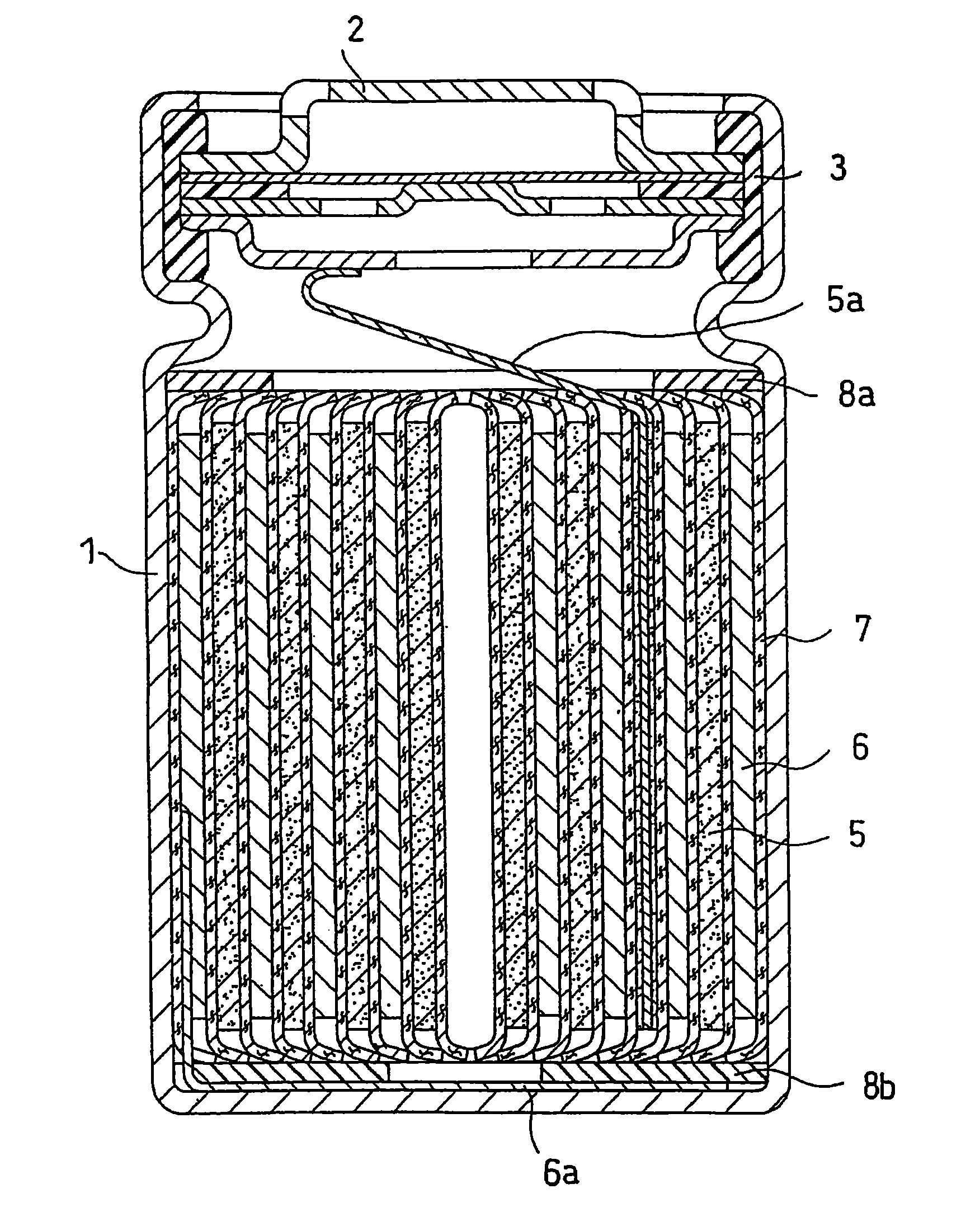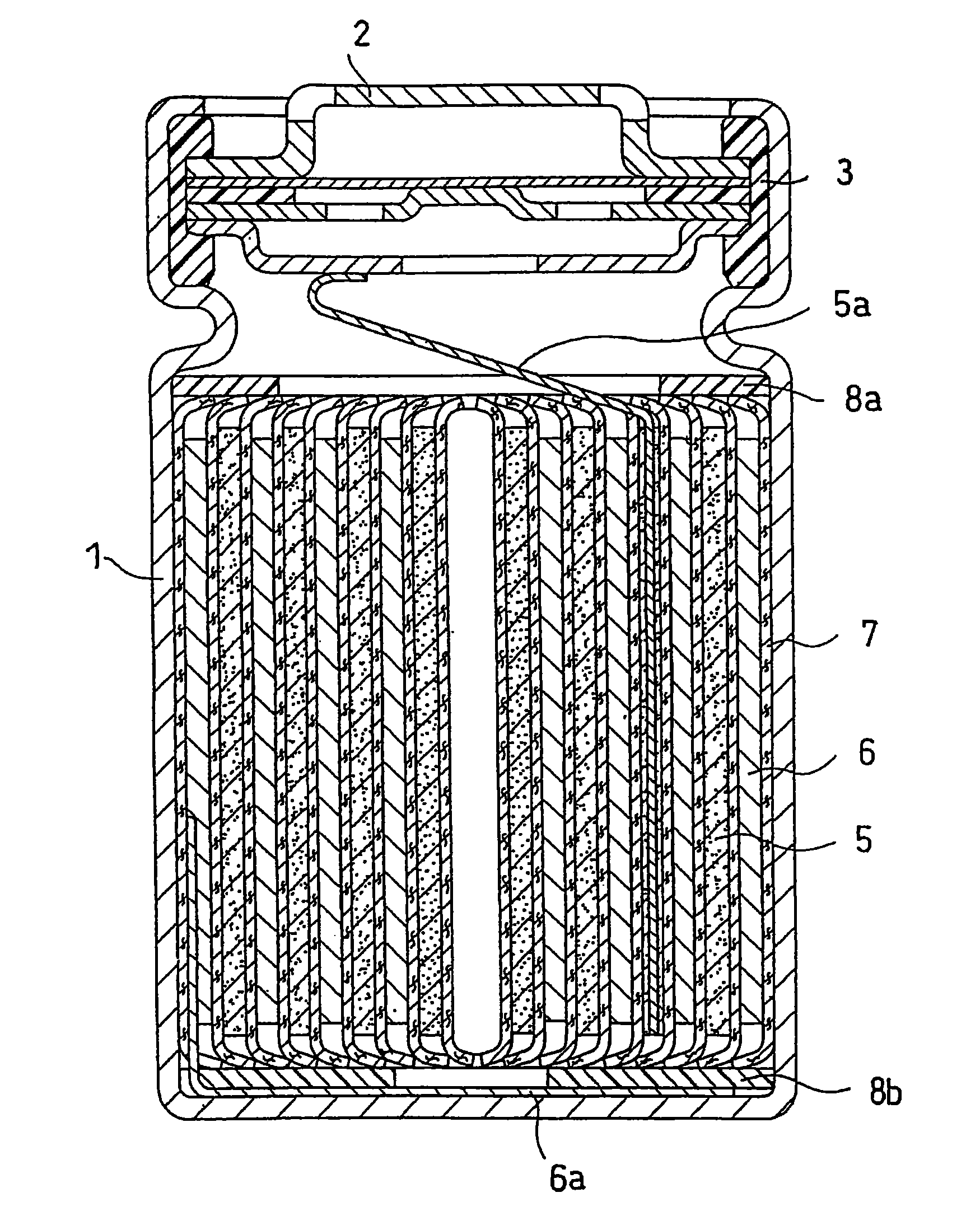Lithium ion secondary battery with improved electrode stability and safety
a secondary battery and lithium ion technology, applied in the direction of cell components, sustainable manufacturing/processing, cell components, etc., can solve the problems of high cost of cobalt compound used as raw material, abnormal heat generation in the battery, and difficulty in curbing heat generation, etc., to improve safety, improve safety, and easy to bring out
- Summary
- Abstract
- Description
- Claims
- Application Information
AI Technical Summary
Benefits of technology
Problems solved by technology
Method used
Image
Examples
example 1
Example Battery A1
(1) Synthesizing Lithium Composite Oxide
[0093]Nickel sulfate, cobalt sulfate, and aluminum sulfate were mixed so that the molar ratio between Ni atoms, Co atoms, and Al atoms was 80:15:5. A raw material solution was obtained by dissolving 3.2 kg of this mixture in 10 L of water. To the raw material solution, 400 g of sodium hydroxide was added, to produce a precipitate. The precipitate was washed sufficiently with water and dried, thereby obtaining a coprecipitated hydroxide.
[0094]To 3 kg of the obtained Ni—Co—Al coprecipitated hydroxide, 784 g of lithium hydroxide was mixed, and the mixture was baked under a partial pressure of oxygen of 0.5 atmosphere, with a synthesizing temperature of 750° C. for 10 hours. As a result, a Ni—Co—Al lithium composite oxide containing Ni and Co as element M, and Al as element L (LiNi0.8CO0.15Al0.05O2) was obtained. As the obtained lithium composite oxide was observed with an electron microscope, it was found that primary particles ...
example 2
Example Batteries B1 to B24
[0134]Nickel sulfate, cobalt sulfate, and manganese sulfate were mixed so that the molar ratio between Ni atoms, Co atoms, and Mn atoms was 80:15:5. A raw material solution was obtained by dissolving 3.2 kg of this mixture in 10 L of water. To the raw material solution, 400 g of sodium hydroxide was added, to produce a precipitate. The precipitate was washed sufficiently with water and dried, thereby obtaining a coprecipitated hydroxide.
[0135]To 3 kg of the obtained Ni—Co—Mn coprecipitated hydroxide, 784 g of lithium hydroxide was mixed, and the mixture was baked under a partial pressure of oxygen of 0.5 atmosphere, with a synthesizing temperature of 750° C. for 10 hours. As a result, a lithium composite oxide containing Co and Mn as element M (LiNi0.8CO0.15Mn0.05O2) with an average particle size 12 μm was obtained. Batteries B1 to B24 were made in the same manner as Batteries A1 to A24, respectively, except that the obtained lithium composite oxide was us...
example 3
Example Batteries C1 to C24
[0137]Nickel sulfate, cobalt sulfate, and manganese sulfate were mixed so that the molar ratio between Ni atoms, Co atoms, and Mn atoms was 34:33:33. A raw material solution was obtained by dissolving 3.2 kg of this mixture in 10 L of water. To the raw material solution, 400 g of sodium hydroxide was added, to produce a precipitate. The precipitate was washed sufficiently with water and dried, thereby obtaining a coprecipitated hydroxide.
[0138]To 3 kg of the obtained Ni—Co—Mn coprecipitated hydroxide, 784 g of lithium hydroxide was mixed, and the mixture was baked under a partial pressure of oxygen of 0.5 atmosphere, with a synthesizing temperature of 750° C. for 10 hours. As a result, a lithium composite oxide containing Co and Mn as element M and having an average particle size of 12 μm (LiNi0.34CO0.33Mn0.33O2) was obtained. Batteries C1 to C24 were made in the same manner as batteries A1 to A24, respectively, except that the obtained lithium composite o...
PUM
| Property | Measurement | Unit |
|---|---|---|
| particle size | aaaaa | aaaaa |
| particle size | aaaaa | aaaaa |
| particle size | aaaaa | aaaaa |
Abstract
Description
Claims
Application Information
 Login to View More
Login to View More - R&D
- Intellectual Property
- Life Sciences
- Materials
- Tech Scout
- Unparalleled Data Quality
- Higher Quality Content
- 60% Fewer Hallucinations
Browse by: Latest US Patents, China's latest patents, Technical Efficacy Thesaurus, Application Domain, Technology Topic, Popular Technical Reports.
© 2025 PatSnap. All rights reserved.Legal|Privacy policy|Modern Slavery Act Transparency Statement|Sitemap|About US| Contact US: help@patsnap.com


